Abstract
A study involving 79 patients who were considered for surgical treatment for craniocerebral gunshot injuries between 1972 and 1978 was carried out to develop criteria for radiographic assessment and surgical operation, as well as to improve operative techniques and preoperative planning. The study focused on differences between military and civilian injuries, as well as criteria for gross prediction of outcome.
Of note in the overall perspective of the series were (1) the predominance of low-velocity missiles, (2) the high rate of self-inflicted injuries (34 percent), (3) the overall mortality of 23 percent with the rate for persons older than 60 being approximately 70 percent, (4) the correlation between preoperative patient assessment and mortality, (5) complications predominated by cerebrospinal fluid fistulas (10 percent), (6) the value of computerized axial tomographic (CAT) scanning in patient assessment and operative strategy and (7) the ultimate employability rate in survivors (78 percent).
An historical review of the development of management principles based on operative experience in the military sector as well as other recent civilian literature also deserves consideration.
Full text
PDF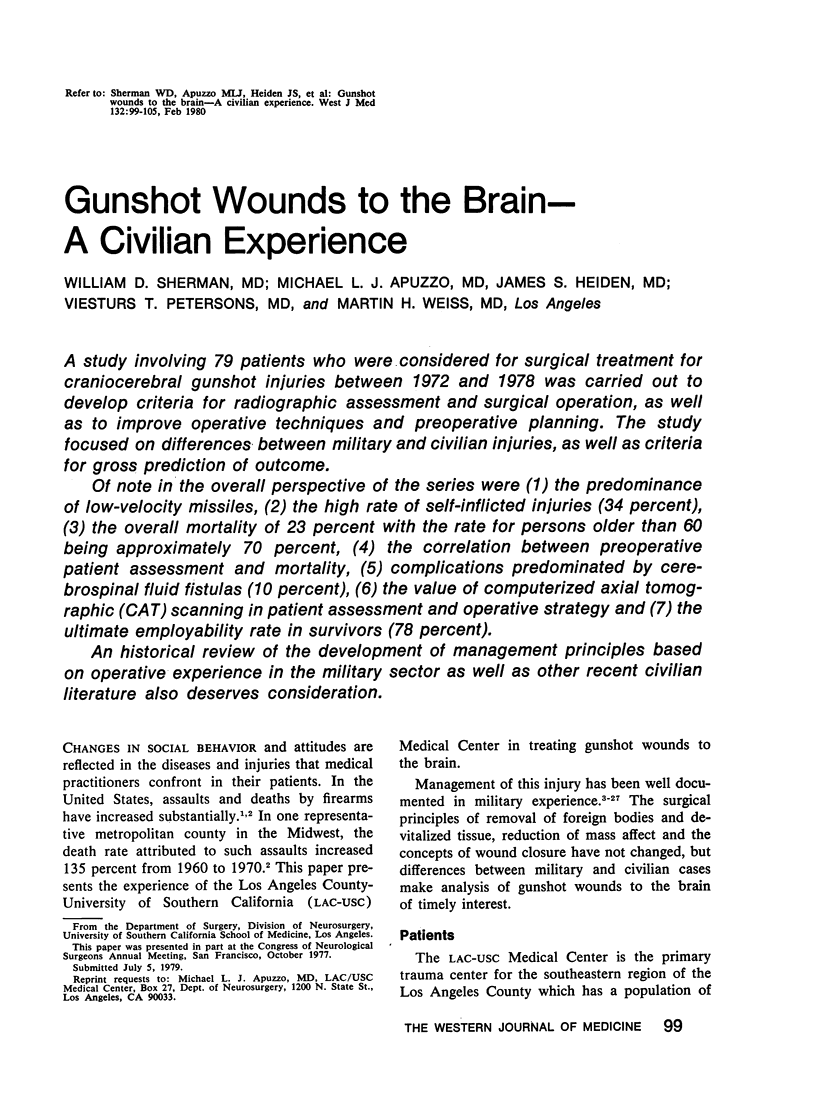
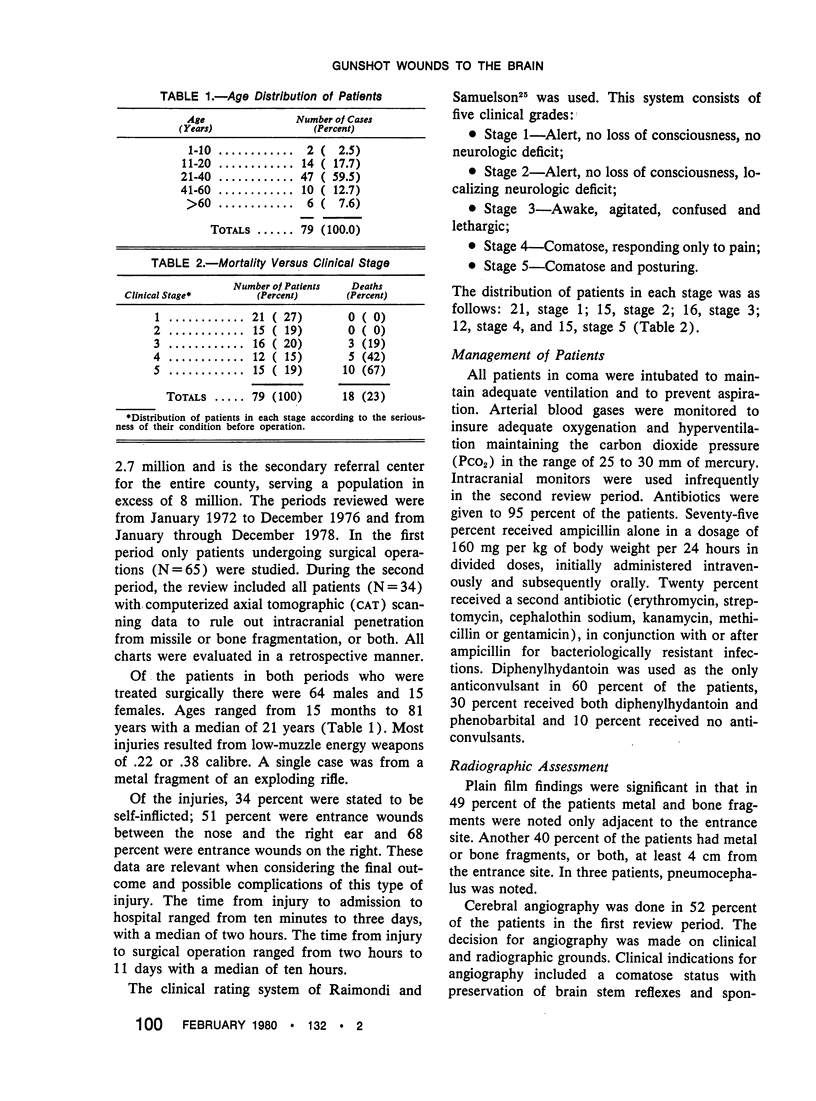
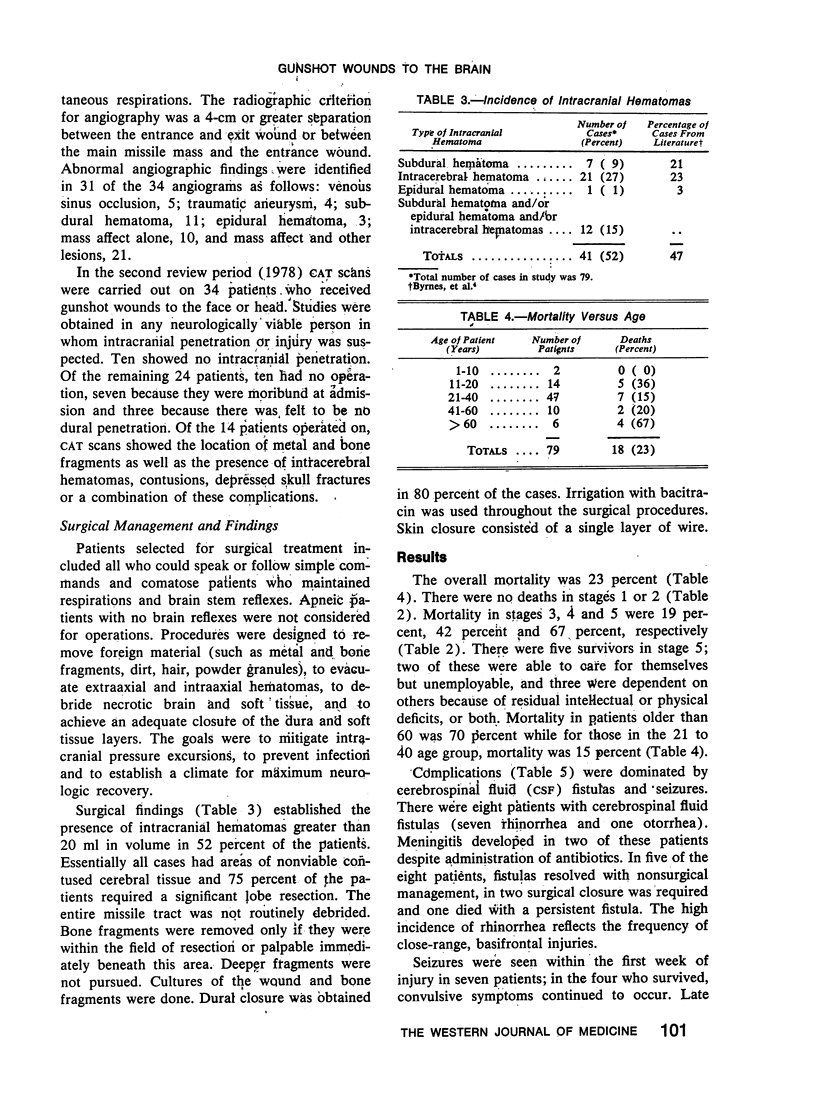
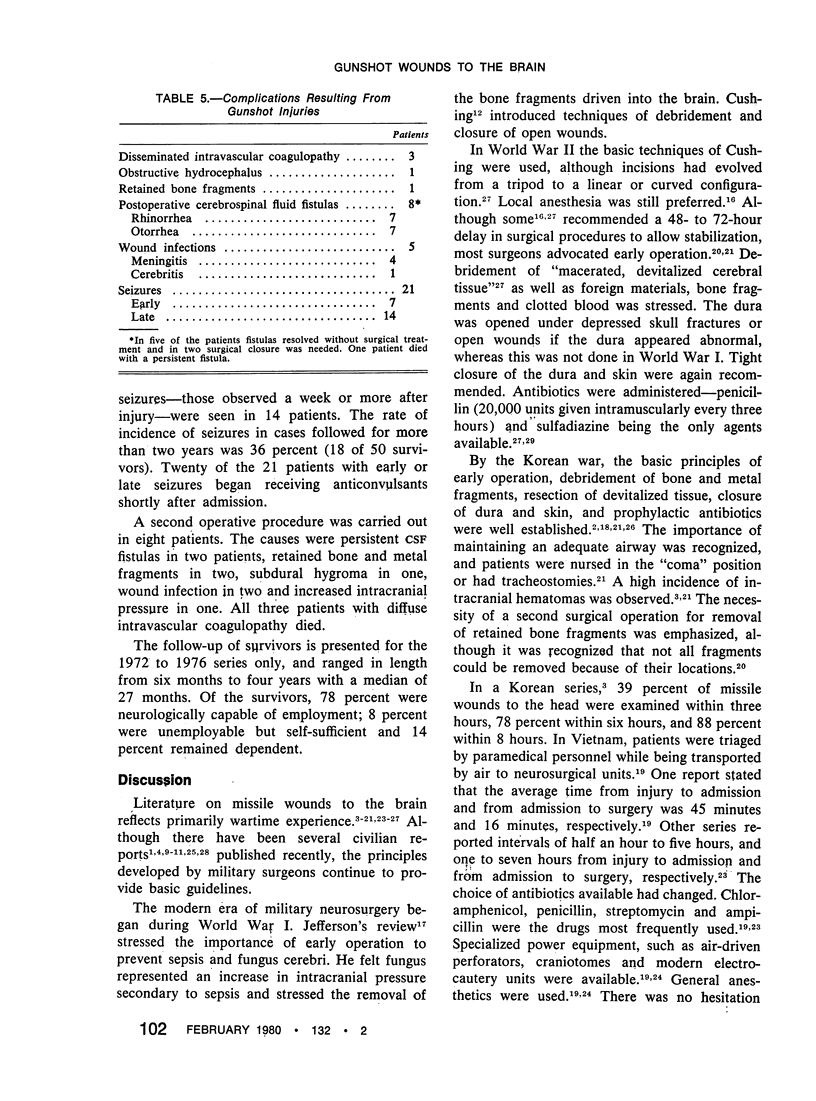
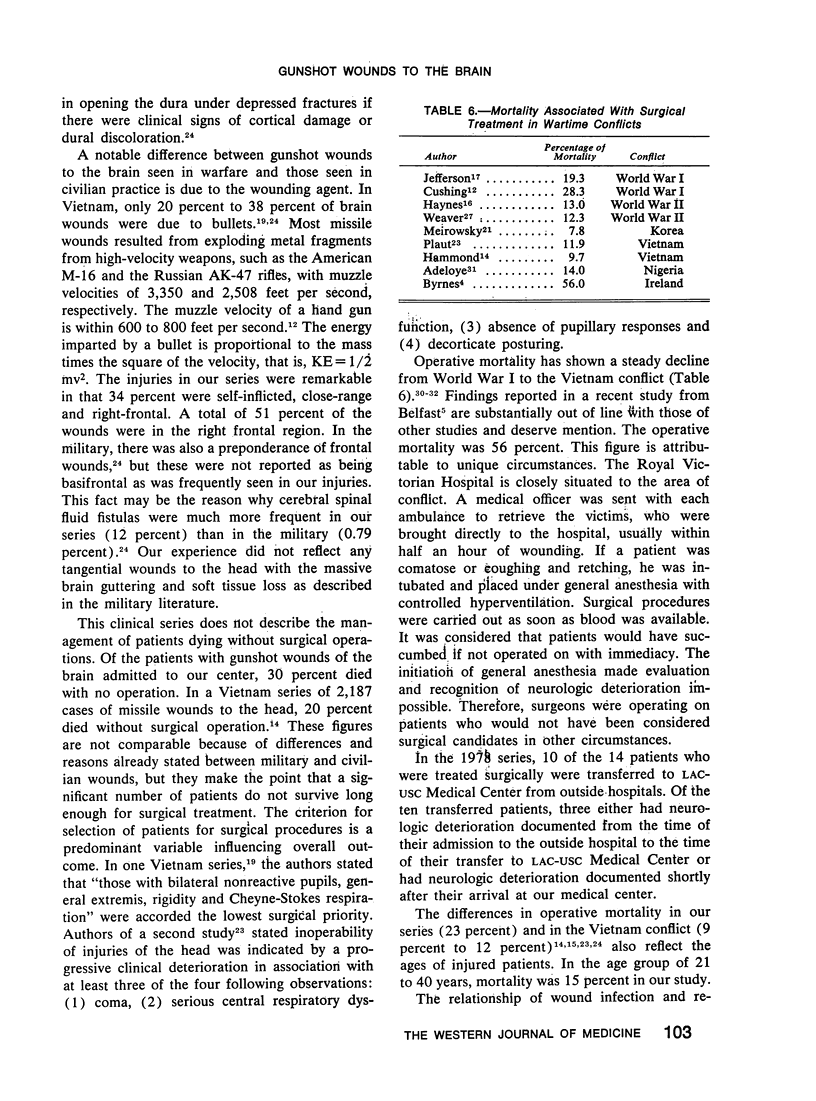
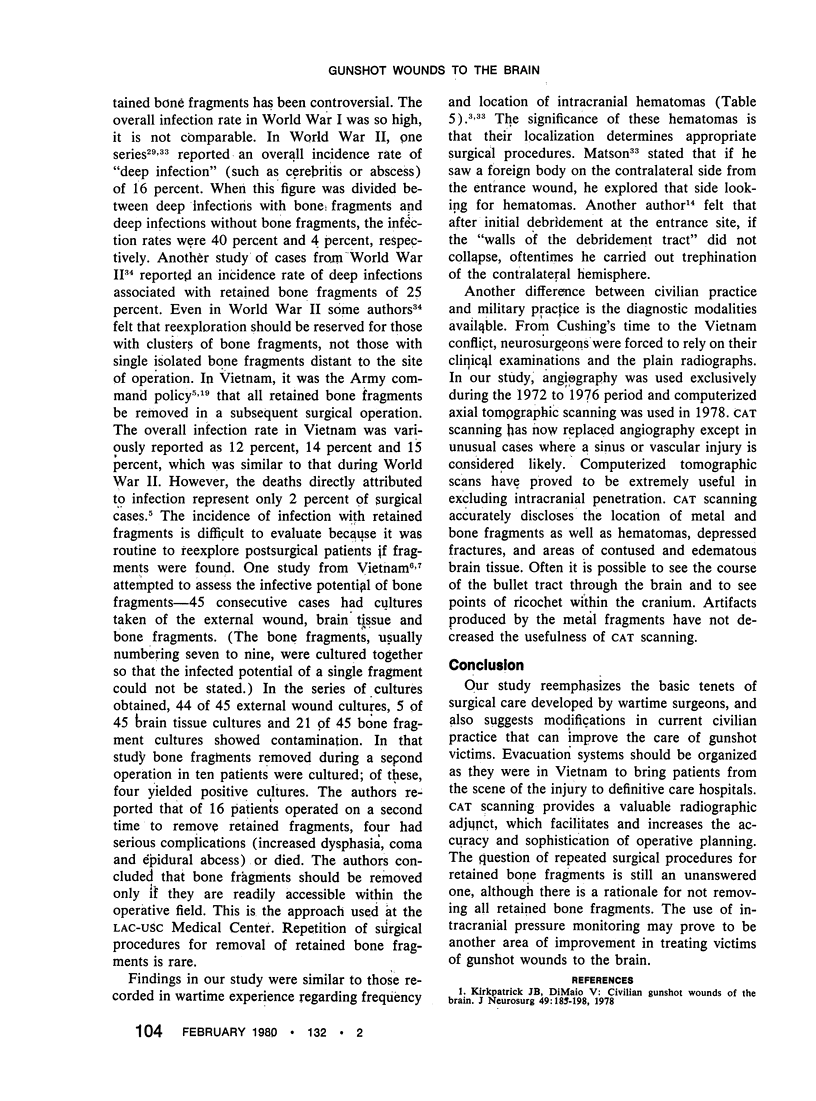
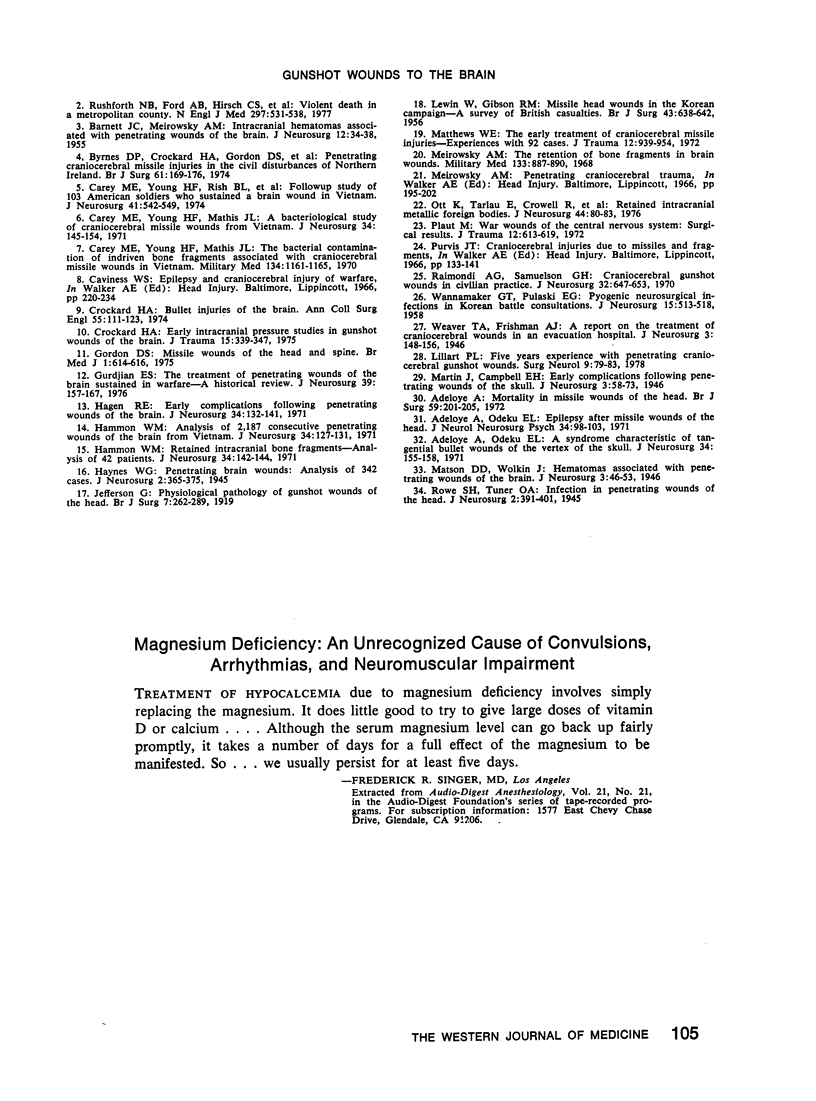
Selected References
These references are in PubMed. This may not be the complete list of references from this article.
- Adeloye A. Mortality in missile wounds of the head. Br J Surg. 1972 Mar;59(3):201–205. doi: 10.1002/bjs.1800590314. [DOI] [PubMed] [Google Scholar]
- Adeloye A., Odeku E. L. A syndrome characteristic of tangential bullet wounds of the vertex of the skull. J Neurosurg. 1971 Feb;34(2 Pt 1):155–158. doi: 10.3171/jns.1971.34.2part1.0155. [DOI] [PubMed] [Google Scholar]
- Adeloye A., Odeku E. L. Epilepsy after missile wounds of the head. J Neurol Neurosurg Psychiatry. 1971 Feb;34(1):98–103. doi: 10.1136/jnnp.34.1.98. [DOI] [PMC free article] [PubMed] [Google Scholar]
- BARNETT J. C., MEIROWSKY A. M. Intracranial hematomas associated with penetrating wounds of the brain. J Neurosurg. 1955 Jan;12(1):34–38. doi: 10.3171/jns.1955.12.1.0034. [DOI] [PubMed] [Google Scholar]
- Byrnes D. P., Crockard H. A., Gordon D. S., Gleadhill C. A. Penetrating craniocerebral missile injuries in the civil disturbances in Northern Ireland. Br J Surg. 1974 Mar;61(3):169–176. doi: 10.1002/bjs.1800610302. [DOI] [PubMed] [Google Scholar]
- Carey M. E., Young H. F., Mathis J. L. The bacterial contamination of indriven bone fragments associated with craniocerebral missile wounds in Vietnam. Mil Med. 1970 Dec;135(12):1161–1165. [PubMed] [Google Scholar]
- Carey M. E., Young H. F., Rish B. L., Mathis J. L. Follow-up study of 103 American soldiers who sustained a brain wound in Vietnam. J Neurosurg. 1974 Nov;41(5):542–549. doi: 10.3171/jns.1974.41.5.0542. [DOI] [PubMed] [Google Scholar]
- Carey M. E., Young H., Mathis J. L., Forsythe J. A bacteriological study of craniocerebral missile wounds from Vietnam. J Neurosurg. 1971 Feb;34(2 Pt 1):145–154. doi: 10.3171/jns.1971.34.2part1.0145. [DOI] [PubMed] [Google Scholar]
- Crockard H. A. Bullet injuries of the brain. Ann R Coll Surg Engl. 1974 Sep;55(3):111–123. [PMC free article] [PubMed] [Google Scholar]
- Crockard H. A. Early intracranial pressure studies in gunshot wounds of the brain. J Trauma. 1975 Apr;15(4):339–347. doi: 10.1097/00005373-197504000-00011. [DOI] [PubMed] [Google Scholar]
- Gordon D. S. Surgery of violence. V. Missile wounds of the head and spine. Br Med J. 1975 Mar 15;1(5958):614–616. doi: 10.1136/bmj.1.5958.614. [DOI] [PMC free article] [PubMed] [Google Scholar]
- Hagan R. E. Early complications following penetrating wounds of the brain. J Neurosurg. 1971 Feb;34(2 Pt 1):132–141. doi: 10.3171/jns.1971.34.2part1.0132. [DOI] [PubMed] [Google Scholar]
- Hammon W. M. Analysis of 2187 consecutive penetrating wounds of the brain from Vietnam. J Neurosurg. 1971 Feb;34(2 Pt 1):127–131. doi: 10.3171/jns.1971.34.2part1.0127. [DOI] [PubMed] [Google Scholar]
- Hammon W. M. Retained intracranial bone fragments: analysis of 42 patients. J Neurosurg. 1971 Feb;34(2 Pt 1):142–144. doi: 10.3171/jns.1971.34.2part1.0142. [DOI] [PubMed] [Google Scholar]
- Kirkpatrick J. B., Di Maio V. Civilian gunshot wounds of the brain. J Neurosurg. 1978 Aug;49(2):185–198. doi: 10.3171/jns.1978.49.2.0185. [DOI] [PubMed] [Google Scholar]
- LEVY L. F. Granuloma of the neck following thorotrast angiography. Br J Surg. 1956 May;43(182):638–641. doi: 10.1002/bjs.18004318218. [DOI] [PubMed] [Google Scholar]
- Lillard P. L. Five years experience with penetrating craniocerebral gunshot wounds. Surg Neurol. 1978 Feb;9(2):79–83. [PubMed] [Google Scholar]
- Mathews W. E. The early treatment of craniocerebral missile injuries: experience with 92 cases. J Trauma. 1972 Nov;12(11):939–954. doi: 10.1097/00005373-197211000-00004. [DOI] [PubMed] [Google Scholar]
- Meirowsky A. M. The retention of bone fragments in brain wounds. Mil Med. 1968 Nov;133(11):887–890. [PubMed] [Google Scholar]
- Ott K., Tarlov E., Crowell R., Papadakis N. Retained intracranial metallic foreign bodies. Report of two cases. J Neurosurg. 1976 Jan;44(1):80–83. doi: 10.3171/jns.1976.44.1.0080. [DOI] [PubMed] [Google Scholar]
- Plaut M. War wounds of the central nervous system: surgical results. J Trauma. 1972 Jul;12(7):613–619. doi: 10.1097/00005373-197207000-00010. [DOI] [PubMed] [Google Scholar]
- Raimondi A. J., Samuelson G. H. Craniocerebral gunshot wounds in civilian practice. J Neurosurg. 1970 Jun;32(6):647–653. doi: 10.3171/jns.1970.32.6.0647. [DOI] [PubMed] [Google Scholar]
- Rushforth N. B., Ford A. B., Hirsch C. S., Rushforth N. M., Adelson L. Violent death in a metropolitan county. Changing patterns in homicide (1958-74). N Engl J Med. 1977 Sep 8;297(10):531–538. doi: 10.1056/NEJM197709082971004. [DOI] [PubMed] [Google Scholar]
- WANNAMAKER G. T., PULASKI E. J. Pyogenic neurosurgical infections in Korean battle casualties. J Neurosurg. 1958 Sep;15(5):512–518. doi: 10.3171/jns.1958.15.5.0512. [DOI] [PubMed] [Google Scholar]


